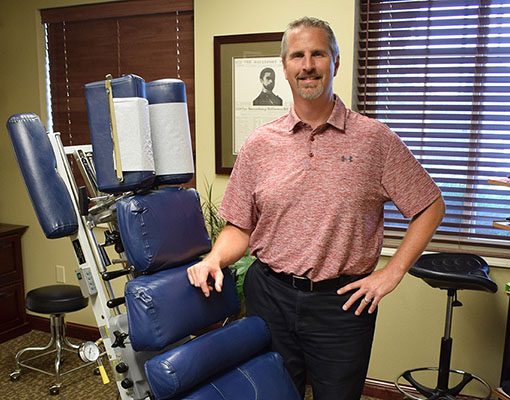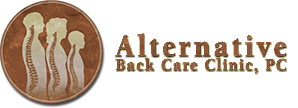Causes and Treatments
Arm and Wrist Pain
CARPAL TUNNEL SYNDROME (CTS)

Pain and numbness/tingling are felt in the palm surface of the thumb and first two and half fingers of the hand. (Note: the pinkie and outer half of the ring finger are not involved in this condition). It is worse at night. Swelling and fine-grasping are sometimes involved. Pain radiates up the arm from the wrist instead of down the arm to the wrist. The carpal tunnel is formed in the wrist with carpal (wrist) bones as walls and a ligament as the ceiling. The median nerve travels through this tunnel and becomes impinged by bones, inflammation, arthritis, and/or scar tissue. CTS is a common buzz-word for any pain in the wrist and hand, so a proper diagnosis is needed for care. Many times the wrist condition is present from a "pinched" nerve in the neck, shoulder, elbow, and /or wrist. Treatment in our office consists of chiropractic adjustments to any "fixed" joint needing mobilization, low level laser therapy, ultrasound, myofascial release, splinting (if needed), nutritional advice, and proper ergonomic counseling. Low level laser therapy has been shown through extensive research to be extremely benifical for carpal tunnel syndrome. Laser therapy was originally approved by the FDA for CTS.
This is one condition that many times ends up in needless surgery. Too many people rush into a poor decision and choose surgery before even attempting conservative. In the case of CTS is it much better to attempt conservative care first. If that is unsuccessful then surgery may be the best option. Remember, once you get cut you can NEVER go back! With surgery you risk the future probability of building up scar tissue in the carpal tunnel and then it has to be redone!!
DE QUERVAIN'S SYNDROME (AKA STENOSING TENOSYNOVITIS)

Pain is in the thumb region of the wrist with a history of activities that require forceful gripping or repetitive use of the thumb. The pain is located where the thumb meets the wrist bones. Conservative care is the best option initially and is our office we use chiropractic adjustments where needed, and underwater ultrasound of the wrist. If the condition does not respond in 2-3 weeks, a brace with thumb splint is required for another 2-3 weeks. If it is still non-responsive, then the patient is referred out for a cortisone shot.
LATERAL EPICONDYLITIS (AKA TENNIS ELBOW)

Pain is located at the outer elbow and is associated with repetitive activity (such as backhand and forehand moves in tennis). “Itis†means inflammation. This condition is actually misnamed and it is now sometimes called epicondylosis because research shows that there is no inflammation present; the tissues are degenerative instead. Gripping and lifting cause pain and it very tender to the touch at the outer elbow. Our care consists of ultrasound, myofascial release techniques, rehab exercises, and adjusting of any "fixed" joints associated with it.
MEDIAL EPICONDYLITIS (AKA GOLFER'S ELBOW)

Pain is located at the inner elbow and is associated with repetitive activity such as hammering or using a screwdriver. There may be pain or weakness with gripping. This condition is also like tennis elbow in that it is not usually an inflammation, as the name suggests, but instead a degeneration of the connective tissues. Our care in the office consists of ultrasound, myofascial release techniques, rehab exercises, and adjusting of any "fixed" joints associated with it.
NURSEMAID'S ELBOW

A child (usually between age 2-4 years old) presents with parent with elbow pain and guarding of the arm by keeping it by their side. An onset of being picked up by the arm or jerking of the child's arm is the most likely cause of this condition. Manual manipulation of the elbow is the treatment of choice.
PRONATOR SYNDROME

Pain is present on the under side of the forearm; there is most often a history of repetitive motions incurred in jobs such as: carpenters, meat cutters, assembly line workers, and weight lifters. This can often refer pain into the wrist and be incorrectly diagnosed as carpal tunnel syndrome. When the pronator teres muscle in the forearm becomes hypertrophied (overly tight), compression of the nerves occurs between the two heads of the muscle Tenderness to pressure on the forearm can be accompanied by pain down the arm. Management of this condition in our office consists of chiropractic adjustments to any"fixed" joint needing mobilization, ultrasound, myofascial release, and training on proper motions. If symptoms persist after six months surgery may be needed.
Why Choose Us?

Because Dr. Bunkers LOVES his job!
-
We do not
require lengthy treatment plans
-
We treat
neck and back problems, headaches, joint problems of the arms and legs such as shoulders, knees, etc.
-
We treat
the entire family from infants to senior citizens
-
We focus
on treating the problem and getting you functioning as soon as possible
-
We help
with your insurance questions
-
We will
refer out for second opinions if your condition does not improve
